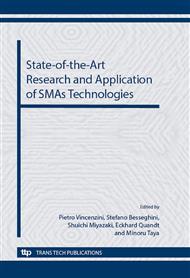p.13
p.19
p.25
p.31
p.40
p.46
p.52
p.58
p.63
Functional Fatigue of NiTi Shape Memory Wires under Assorted Loading Conditions
Abstract:
The rational design of shape memory alloy (SMA) actuators requires reliable data on the fatigue strength of the material under cyclic thermal activation (functional fatigue). Test results on SMAs under functional fatigue are scarce in the technical literature and the few data available are mainly limited to constant-stress loading. Since the SMA elements used within actuators are normally biased by elastic springs or by another SMA element, their stress state is far from constant in operation. The mismatch between actual working conditions and laboratory arrangements leads to suboptimal designs and undermines the prediction of the actuator lifetime. This paper aims at bridging the gap between experiment and reality. Four test procedures are planned, covering most of the typical situations occurring in practice: constant-stress, constant-strain, constant-stress with limited maximum strain and linear stress-strain variation. The paper describes the experimental apparatus specifically designed to implement the four loading conditions and presents fatigue results obtained from commercial NiTi wires tested under three of the four protocols.
Info:
Periodical:
Pages:
40-45
Citation:
Online since:
September 2012
Authors:
Price:
Сopyright:
© 2013 Trans Tech Publications Ltd. All Rights Reserved
Share:
Citation:


